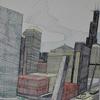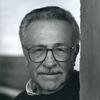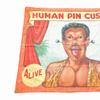Take A Virtual Walk-Through of Desert X 2021 in the Coachella Valley
- May 04, 2021 11:31
After a postponement due to pandemic stay-at-home orders, Desert X 2021 is in its final weeks of a 9-week (to May 16) run in multiple loactions across California's Coachella Valley. On-site visitors can download a mobile app for exact locations and information on artworks.
This third edition of the international art exhibition was curated by Desert X Artistic Director Neville Wakefield and Co-curator César García-Alvarez.
“For Desert X 2021, we took our cues from the way deserts are formed, from the natural processes that weather their surfaces and expand their geographies," said García-Alvarez. “Acting upon this place, the projects seek to identify and uplift lesser known and complex stories of immeasurable impact through conversations between the lived experience of people here with those who came before them and the realities that we live in now. We refute the dichotomy of local versus global, and instead champion the nuances that connect both.”
Among the first art experiences in the region since widespread lockdowns, Desert X offers safe, outdoor settings that are free and open to all. Newly commissioned works explore themes of land rights and ownership, the desert as border, migration, water exploitation, social justice, racial narratives of the West, the gendered landscape and the role of women and young people.
Site-responsive installations by a near-dozen renowned international contemporary artists activate the desert landscape, both as a place and idea.
“As much as the desert is a state of place, it is also a state of mind. Its borders are not singular but multiple, and it is defined as much by social geography as physical boundary,” said Wakefield. “Desert X 2021 seeks to explore this idea of the desert as a place where the marginalized and migratory - whose voices and histories may have struggled to manifest within the dominant discourses of growth and development - can also be heard.”
In What Lies Behind the Walls, Zahrah Alghamdi creates a monumental sculptural wall, which, like a geological extrusion, reveals the different stratas of time as they have been captured both in millenia of geological transformation and the last few centuries of rapid development so connecting the desert landscape of the Coachella to the transformations of other deserts across the globe.
Women’s Qualities by Ghada Amer is a social project that polled diverse communities within the Coachella Valley, whose representations take the form of word gardens that are dependent on nature, care and other activities traditionally associated with femininity.
Felipe Baeza’s mural Finding Home in My Own Flesh will be on view soon, say organizers. It will depict two hands enveloping a cloud of vines and flowers, speaking to the erasure of marginalized peoples from both official narratives and our collective imaginaries.
In The Wishing Well, Serge Attukwei Clottey speaks to the challenges various communities face when accessing potable water. Structures made from Kufuor gallons, used in rural regions of Ghana to move water from sources to homes, echo a standing well—a place to journey to in search of what should be a more accessible, natural resource.
Never Forget by Nicholas Galanin addresses the issue of monuments and what they memorialize, functioning as both a raising of consciousness and a call to action, that by linking to the landback movement, interrogates the ideas of land on which the land art movement has been historically based.
Requiring a steep climb to get to (and reservations recommended), Alicja Kwade’s sculptural work ParaPivot (sempiternal clouds) is at once an atomic model and a geological proposition. The seemingly icy, stone fragments, in contrast to the desert, reference current global issues, ideas of space– both micro and macro, relativity and time between terrestrial land and outer space.
In a new chapter of his ongoing project Frequencies, specially modified for the home learning experience brought upon by the pandemic, Oscar Murillo collaborates with hundreds of young people from schools across the Coachella Valley to broaden an archive, via student-intervened canvases, that indexes the experiences of young people through mark-making.
Christopher Myers’ The Art of Taming Horses explores the relationship between myth and history to shed light on lesser known stories of the region. Through a new series of equestrian sculptures adorned with narrative banners Myers tells of African-Americans who traveled South to escape bondage and of Mexican-Americans who journeyed north for a better life. Through a fictional story of a pair of cowboy friends, one African-American and one Mexican, Myers shed light on the kinds of lives these communities could have had here one day.
In The Passenger, a large-scale maze structure made from woven palm tree fiber walls, Eduardo Sarabia examines the desert as a border through the trope of the journey—a motif that connects peoples across geographies and cultures.
Xaviera Simmons employs billboards in Because You Know Ultimately We Will Band A Militia to craft language and image that confronts white stereotypes and complicity within narratives that shape our societal structures.
In a diorama representing the life of one of the early homesteaders, Kim Stringfellow's Jackrabbit Homestead chronicles one of the less remembered histories of desert land that belongs to the Jackrabbit homesteader, which began in 1938 with Southern California’s Small Tract Act.
Inspired by pictures of the region that have helped construct its visual imaginary, Vivian Suter’s Tamanrasset is an installation of paintings and light inside an iconic modernist building. The work translates the desert terrain, as image, into abstracted forms and colors—drawing attention to the desert as a condition with emotional and psychological dimensions.
Judy Chicago, known for her innovation over a 50-year career, was planning to unveil a new (and non-toxic) smoke piece, Living Smoke, to celebrate the desert. The organizers noted that she chose to not move forward with the alternative location for her project.
Visit Desert X for more information and to download the visitors' app.





















